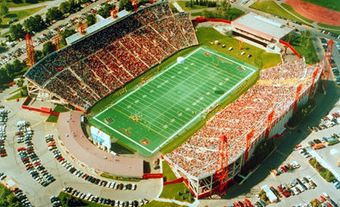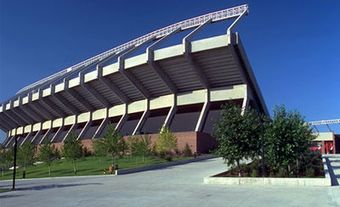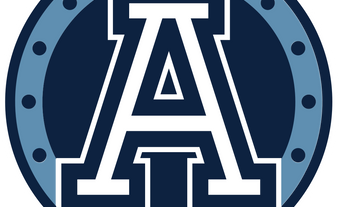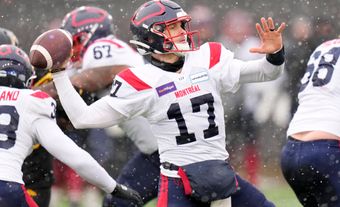The Canadian Football League (CFL) began its formal existence in January 1958. It represented a merger of the Interprovincial Rugby Football Union (founded in 1907) and the Western Interprovincial Football Union (founded in 1936). Currently, the Ottawa Redblacks, Hamilton Tiger-Cats, Toronto Argonauts and Montreal Alouettes make up the East Division. The Winnipeg Blue Bombers, Saskatchewan Roughriders, Calgary Stampeders, Edmonton Elks and BC Lions play in the West Division. Each team plays 18 games in a 21-week season (June to October) to qualify for the playoffs and a chance to compete for the Grey Cup — the oldest professional football championship in North America. The league has had a colourful history that includes many memorable Grey Cup games, repeated financial difficulties, the death and rebirth of two franchises and a failed expansion to the United States.
Background and Formation
Football under formalized rules has been played in Canada since the 1860s. The Grey Cup was first awarded in 1909. The Canadian Football League (CFL) began its formal existence in January 1958. It had been previously known as the Canadian Football Council (CFC). The CFC was formed in 1956 as a loose merger of the Western Interprovincial Football Union (founded in 1936) and the Interprovincial Rugby Football Union (founded in 1907).
Through the CFC, professional football came under its own jurisdiction without outside interference. Yet, it was at this time that the game also began to show subtle American influences. The value of a touchdown was changed from 5 to 6 points. Twelve Americans were allowed to dress for the Grey Cup game, up from 10 the previous year. In 1957, the Council approved the change of position names to reflect those used in the US: snaps became centres; inside wings, guards; middle wings, tackles; outside wings, ends; flying wings, wingbacks.
The Ottawa Rough Riders (now the Ottawa Redblacks), Hamilton Tiger-Cats, Toronto Argonauts and Montreal Alouettes formed the eastern division. The Winnipeg Blue Bombers, Saskatchewan Roughriders, Calgary Stampeders, Edmonton Eskimos (now the Edmonton Elks) and BC Lions made up the western division.
Early History
There was no interdivisional play until 1961. Each conference decided a winner to meet in the Grey Cup game. Limited interlocking play after 1961 allowed east-west rivalries to develop. This acted as a catalyst for the growth of the league. By 1981, both divisions were playing 16 games in a fully interlocking schedule. The league had reached a peak of success.
In 1986, the schedule was increased to 18 games. The structure and success of the league had allowed for non-profit community ownership of the local teams. Only the Toronto, Hamilton and Montreal franchises had been privately owned. Gate receipts and lucrative TV contracts allowed teams to remain profitable.
1980s
The early 1980s appeared promising for Canadian football. The fortunes of the CFL appeared to be at an all-time high. Attendance climbed, sponsorship appeared to be increasing and the Grey Cup game was played indoors for the first time at BC Place Stadium. At the same time, the success was simply a veneer. After leading the league in attendance in 1977, averaging 59,525 spectators per game, the Montreal Alouettes were in serious financial trouble in 1982. The team was reconstituted as the Montreal Concordes before folding prior to the 1987 season. This forced the Winnipeg Blue Bombers to the eastern division.
By the late 1980s, attendance had dropped significantly at Grey Cup games. Sound financial contracts with sponsors like Carling O'Keefe and various TV networks were not forthcoming. The subsequent decline in attendance, gate receipts and TV revenue hit the CFL and its franchises hard. The loss of the Montreal club intensified the league’s financial troubles. The imposition of a salary cap curtailed excess spending. But franchises in Calgary, Ottawa and BC all required infusions of private capital to continue operations. There remain only three teams with community ownership: Winnipeg, Edmonton and Saskatchewan.
1990s
Private ownership led to more aggressive marketing and finally to expansion into the United States. The Sacramento Gold Miners were added to the league in 1993, followed by teams in Baltimore, Shreveport and Las Vegas in 1994. Concerns over the Americanization of the league were legion, especially among Canadian players. The success of the Baltimore franchise, which reached the Grey Cup in their inaugural 1994 season, only deepened these concerns.
The league, however, was committed to US expansion. The Sacramento franchise was moved to San Antonio before the 1995 season. Las Vegas, which failed miserably on and off the field, was put on hiatus while new ownership could be found. Franchises were awarded to Memphis and Birmingham for 1995. The league continued to pursue other US locations. The Baltimore Stallions proved to be the only franchise to achieve any success. They led the CFL in attendance in both 1994 and 1995 and defeated the Calgary Stampeders in the 1995 Grey Cup. The other four US teams all failed at the gate and folded following the 1995 season.
After the NFL’s Cleveland Browns moved to Baltimore in 1996, the Stallions relocated to Montreal for 1996. The Alouettes franchise was revived. With the re-emergence of Montreal, the league returned to its traditional format of four teams in the east and five in the west. Winnipeg shuttled westwards.
While the US expansion experiment failed, much-needed money was poured into the CFL through expansion fees. A US cable TV contract was renewed for 1996. The league survived the 1996 season and instituted a salary cap to ease its financial problems. In the late 1990s, attendance in the CFL grew, sponsorships increased and television network ratings went up. Nevertheless, the Ottawa Rough Riders were disbanded in 1996. The league was once again forced to move Winnipeg eastwards.
2000–Present
By all accounts, the 2002 season was a success for the CFL. Two teams that had previously folded, the Ottawa Rough Riders (now Ottawa Redblacks) in 1996 and Montreal Alouettes in 1987, had both made successful comebacks in recent years. The Alouettes won the 2002 Grey Cup against the Edmonton Eskimos (now Edmonton Elks).
Canadian football was also staging a remarkable comeback in Quebec at every level. TV ratings were up on both TSN and CBC. A new three-year collective agreement had been struck with the Players' Association, which added an additional import player to each roster and increased the salary cap by $160,000 to $2.44 million annually per club.
Despite its recent success, the CFL continues to have pressing concerns. Attendance has declined in Vancouver and Hamilton. A positive perception of the CFL is still lacking in Toronto. All this must be solved before revenues through television fees can be dramatically improved.
Yet, notwithstanding its past financial difficulties and ever-changing face, the CFL remains a unique part of Canadian sports culture. The Grey Cup continues to draw a large TV audience, with more than 3.5 million viewers (2.8 million in English on TSN, and 263,700 in French on RDS) in 2023. Awards to players are given out during the Grey Cup Week festivities. League offices are in Toronto. The Canadian Football Hall of Fame and Museum is located in Hamilton.
See also Football in Canada; Grey Cup; Fog Bowl: The 1962 Grey Cup.

 Share on Facebook
Share on Facebook Share on X
Share on X Share by Email
Share by Email Share on Google Classroom
Share on Google Classroom








